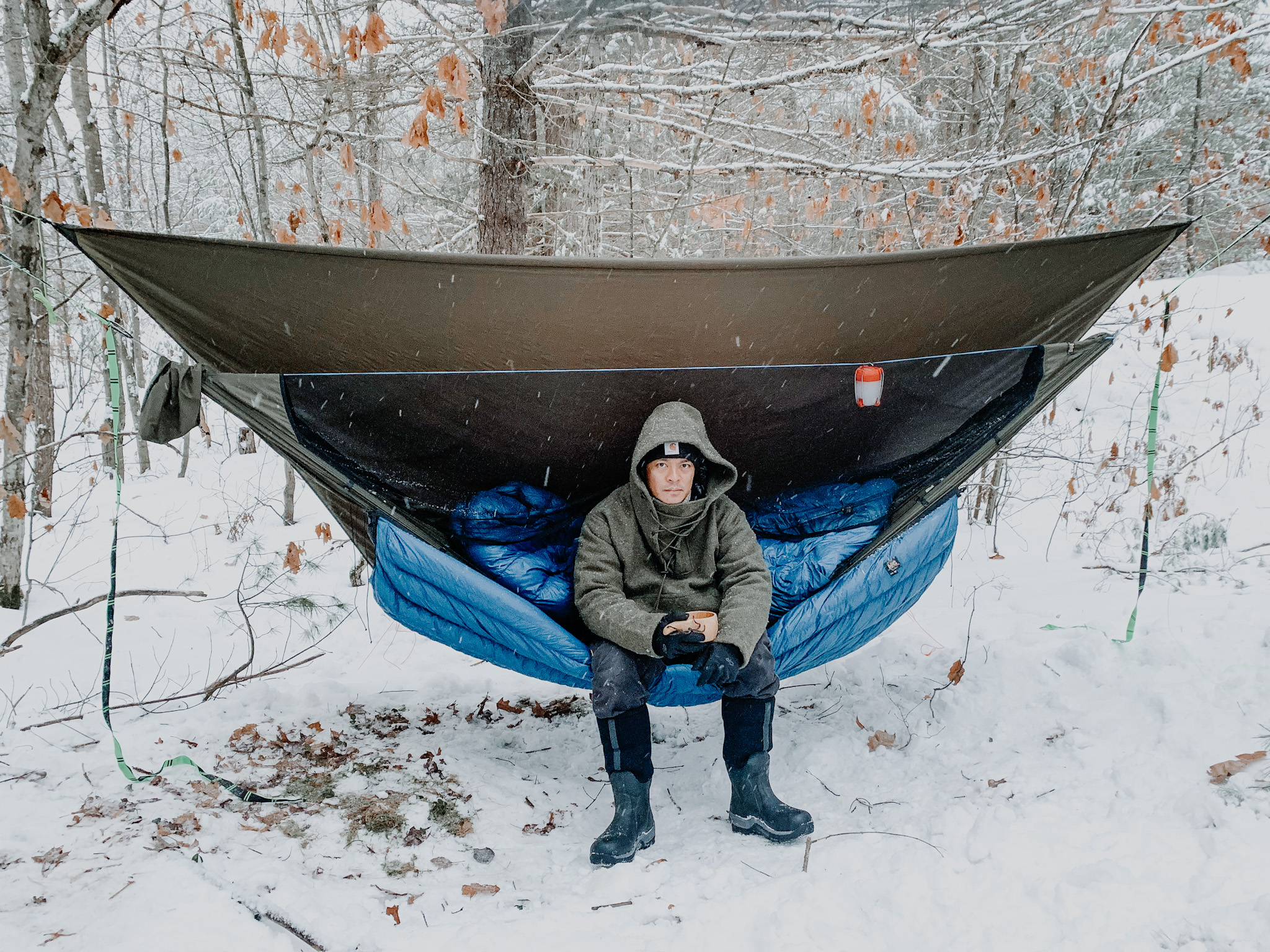What To Expect On Your First Hammock Camping Trip


I just got home from my first ever backcountry hammock camping trip, having never slept in a hammock before, and I’m stoked to report that it was a huge success! However, I must admit that I was very skeptical at first. Will I be able to get comfortable? Can I actually fall asleep in a hammock? Will I be warm enough? The answer to all of the above is a resounding yes! Not only was I sleeping great by the end of the trip, I was also reducing the weight of my pack! Here are my 10 takeaways from a five-day, hammock-camping-only, Appalachian Trail section hike through Shenandoah National Park using The Wanderlust Complete Hammock Camping Kit.
The search for trees was a breeze – Campsite selection always begins with assessing the trees, and I found the search to be oddly satisfying. To set up a hammock like the Wanderlust, all it takes is two trees that are roughly 12’-18’apart. That’s it! Whether front or backcountry camping, compatible sites are abundant along the AT, and honestly, wherever trees grow. We spent no more time searching for good trees than I have scouting campgrounds for the biggest, flattest tent sites.
Set up is shockingly easy – Once we found our trees, hammocks were up in five minutes. I got a very quick lesson in hammock setup on night one, and thereafter, was off to the races, setting up my own hammock for the remainder of the trip. It requires no fancy gear knowledge or knot skills, and anyone can do it on their first try. If you’re curious, here’s how to set up The Wanderlust hammock, likely the easiest available.
It’s the comfiest lounging ever – If you’ve hung out or napped in a hammock before, then you know how comfy they are. If you haven’t, well, you’re in for a treat! No foam or inflatable ground pad even comes close to how relaxing a hammock is. They’re great for reading, chatting, munching, or just straight chillin’ out and absorbing the scenery.
No, it’s not cold at all – A common concern among those who have “hung out,” but may never have slept in a hammock before, is that their back will get cold. Never fear! A proper backcountry hammock kit includes an underquilt, which insulates below you and works in conjunction with a top quilt to wrap you in a multi-layered burrito of coziness. On my trip, it dropped to just above freezing one night and I was still totally warm. I used the Economy Burrow top quilt and Economy Incubator underquilt, which can be purchased together as part of the Wanderlust Complete Hammock Camping Kit package at a great discount.
All your night stuff is within arms’ reach – Going into it, one concern I had was, where do I keep my phone, headlamp, and knicknacks? Don’t worry, that’s all been figured out! Just pick up a Ridgeline Organizer, which is a sliding storage pocket draped above you on the ridgeline, and your sleeping accessories will always be readily accessible.
Hammock sleeping may take getting used to – Of course, the same could be said about transitioning from the bed to a ground pad. Did you sleep well on your first night in a tent? How well you sleep in a hammock probably depends on how easily you’re able to fall asleep in general. Here’s some context: I can’t sleep on planes, in cars, or when the TV is on. In bed and on ground pads, I always and only sleep on my left side. On my first two nights, (in uncomfortably warm/humid conditions), it took me an hour to fall asleep. On my third night, it took me only half an hour, and by the fourth and final night, I fell asleep almost instantly. The situation improved rapidly! Which leads me to my next takeaway.
Don’t give up after your first night – Looking back, had I abandoned my hammock after only one night, I would have really regretted it. Hammock camping offers a multitude of benefits that I would have entirely written off and never gotten to experience (ultralight, ultra-comfy, great views, great in rain, etc). If you’re concerned about being able to fall asleep, practice at home for a couple nights before taking it out.
You won’t contour like a banana – If pitched and slept in correctly, you won’t be sleeping with your butt a foot below your head. For maximum flatness, hammock campers usually sleep diagonally, such that their feet are up against the far left or right edge of the leg section,and their head and shoulders rest against the opposite edge of the torso section.
Side-sleeping, back-sleeping, and everything in between – I came to hammock camping as a side-only sleeper. Despite my very best efforts and many sleepless hours, I’ve never been able to sleep on my back; until now. So, one of the coolest parts of my foray into hammock camping was that I back-slept for the first time ever! Side sleeping is still possible in a hammock, but in a strange reversal, it actually didn’t work for me. If you are a side sleeper, fetal position and straight bodied can both work. And don’t hesitate to try off-angles. Test a 45-degree slant and see if that’s comfy for you. I’m told everything is possible and to think outside the box (literally, you can even drape a foot).
Watch out for these three easy mistakes I made – The first of three mistakes I would like to point out involves pitching. The ridgeline above the hammock should be taught when you put your weight in it but show a little slack when unweighted. If it’s taught before you sit down, you need to reduce the tension. The second mistake is pitching too high. Make sure your feet can rest flat on the ground when sitting upright in the center of the hammock. Since there’s no floor, you want to be able to put on your shoes comfortably and easily as part of the exit process. Lastly, the third common mistake involves sitting into the hammock. Be extra careful on your first few tries. If you undershoot, you could land in between the underquilt and the hammock. If you overshoot, you might rip a human-sized hole through the bug mesh on the far side (if it’s zipped up). Either way, be sure to put a hand down and spread out a bum-sized area to target before you get situated.
While hammock camping is very beginner friendly, it never hurts to go with an expert. I was lucky to have the guidance of ultralight backpacking gear expert Adventure Alan for an in-person rendition of hammock camping 101. Alan and his partner Alison prefer Hammock Camping to tents whenever possible, and you can read his complete review of The Wanderlust Hammock Camping Kit here.
All said and done, I couldn’t be happier about my first-time hammock camping. I came into the trip as a skeptic and finished completely convinced that hammocks are a phenomenal, efficient way to sleep in the woods. Whether you’re an outdoors-person looking to try something new or a seasoned backpacker looking to lower your pack weight with affordable ultralight gear, I highly recommend trying The Wanderlust Hammock Camping Kit. It’s a fully self-contained, complete, hammock sleep system, including the hammock and its attachments, a 20-degree top and underquilt, plus a full-size tarp shelter.
Happy hiking, happy hanging, and happy camping!
Related Posts
The Best Camping Hammocks of 2024 – A Buyer’s Guide by Hammock Gear
A good camping hammock can completely transform how you experience…
Can Napping Hurt You? Unveiling the Pros & Cons of Daily Zzz’s
Napping, the act of taking a brief sleep during the…


